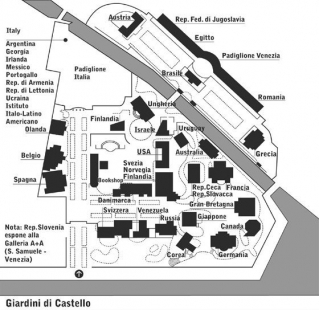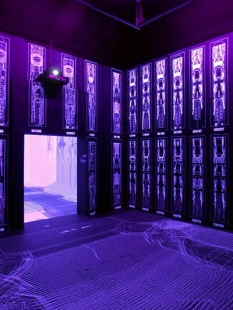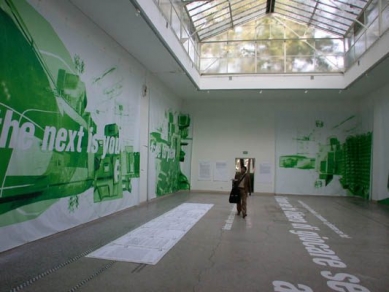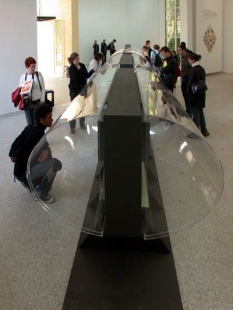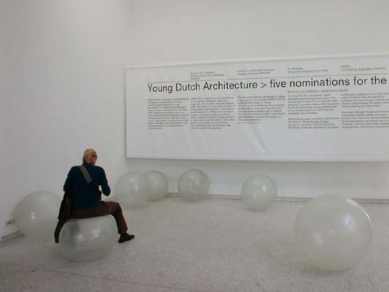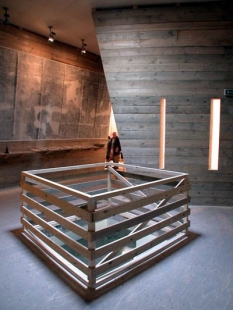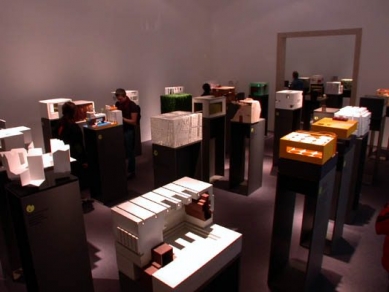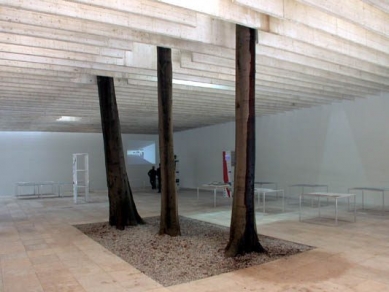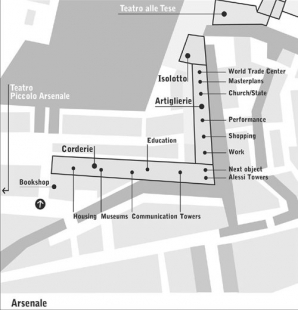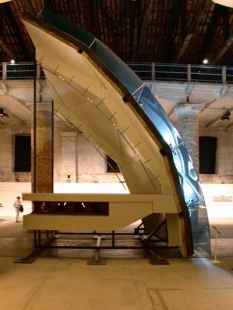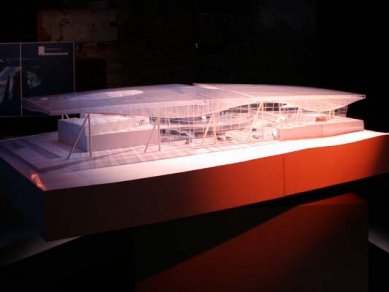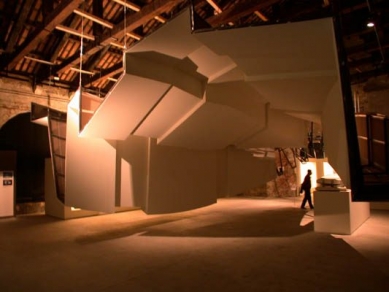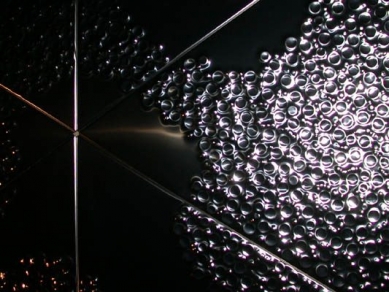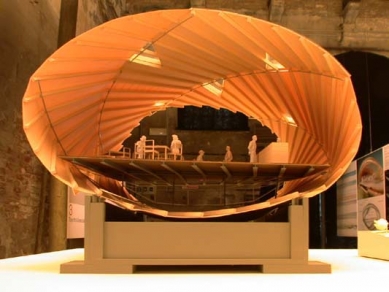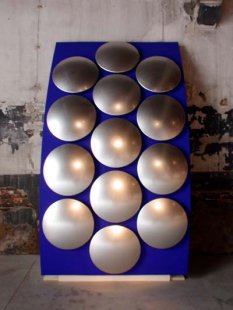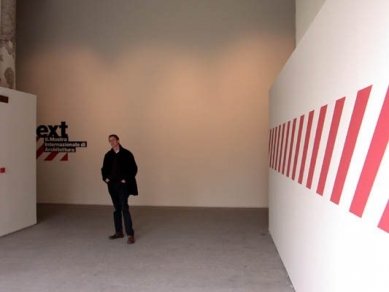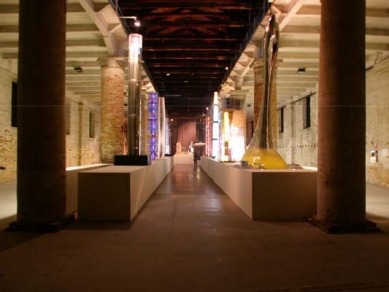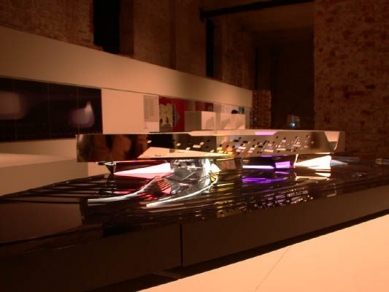
8. Venice Biennale

The last Biennale NEXT, this time under the baton of Deyan Sudjić (founder of the magazine Blueprint and current editor of Domus), returned to the old roots of the architect's profession. It was less digitized and chaotic than Fuksas' two years ago and perhaps for that reason has a chance of surviving as an accompanying catalog.
Argentina Arquitecturas del Sur
Belgium Les Iles Flottanes
Brazil Favelas Upgrading
Chile
Czech and Slovak Republic - The Future of Architecture without Architects. One of the biggest disappointments. The authors of the exhibition David Kopecký and Ján Studený contradicted each other in what they preached and exhibited. Everything seemed amateurish, which did not excuse the fact that it was created by non-architects. The whole pavilion thus became a thoroughfare between France and Scandinavia. I don't understand how respected figures like Rostislav Švácha or Imro Vaško could support such a shaky exhibition. He humorously noted that our exhibition had gained prominence in global architectural circles (the fact that it is on the opposite side of popularity is obvious). The Swiss exhibited far less (actually nothing and still diluted oxygen for you), but at least they didn’t attempt dead themes.
Denmark Copenhagen X
Egypt The Next Story. I initially thought the material spilled on the floor was salt, mistakenly. The exhibition will engage your olfactory senses and everything feels like it’s from the Pharaohs’ era.
Finland Before Next: Learning from Roots. Mikko Heikkinen and Markku Komonen from Helsinki approached the Biennale theme in the most natural way. Before we look at what comes next, we must look back and learn from the past. The sand-filled pavilion of this Nordic country presents current projects by young Finnish architects on the African continent.
France Contextes. Probably the most Next.
Netherlands Fresh Facts. The best buildings by young architects under 40, awarded by the Netherlands Architecture Institute, were exhibited in Rietveld pavilion under the direction of curator Herman Hertzberger.
Ireland Merrit Bucholz & Karen McEvoy: Limerick County Hall
Israel Borderline Disorder. The theme was more like TODAY. The transferred atmosphere of fear and isolation from today’s Jerusalem into the Venetian gardens.
Italy Padliglione Italia
Japan Asian Characters: The creation of architectural language in regions where Kanji are used. New directions presented with humility towards the past.
Socialist Federal Republic of Yugoslavia Destruction & Construction 1991-2002
Lithuania The Castle of Light
Canada Next Memory City. Experimental exercises with Photoshop and Premiere filters. The theme had more in common with the superficiality and vividness of Wallpaper magazine.
Hungary
Mexico Between "Sharp Boxes" and "Potato shapes" - Boolean operations on solid in architectural design, The Lakes Project - The Next Mexico City
Germany NEXTliegend. The most emotionally friendly exhibition, as I personally participated in the project contribution of German students from the very beginning. It did not end in the usual way, where selected superstars boast about their latest realizations regardless of the stated theme. The following (Nextliegend) was for Germans, a young generation of architecture students, who selflessly offered space from ten university professors.
Portugal Quattro Progetti
Austria Integazzione, Madness with a Method (H.Gerngross + R. Köberl). The second funniest exhibition of this year's Biennale. It can warm our hearts a bit that it was linked to two personalities of Czech origin (one of whom is the author of the pavilion and the other a theoretician of architecture from the turn of the last century). The second half was terrible. I do not know whom to applaud.
Romania Romania mon Amour
Russia Two Theatres. A thing previously unseen. The Russian exhibition was represented by more than fifty percent with projects by American neo-expressionist Eric Owen Moss.
Greece Athens 2002: Absolute Realism
Nordic countries Next Nordic
Slovenia Acqua Terra Casa Luce
Spain Paisajes Internos
Switzerland Hormonorium (Ph. Rahm + J.G. Décosterd). One of the wittiest and traditionally most minimalist exhibitions. A room built upside down, diluted air like being at an altitude of 2500 meters above sea level and dazzling fluorescent light combined with vibrating sofas.
Ukraine For many visitors, it remained incomprehensible. Perhaps because the futuristic urbanism created on the knee does not have the right zest.
USA The World Trade Center: Past, Present, Future. Originally, it was supposed to represent the Embryological House by FORM (Greg Lynn). In the end, political lobby won, transferring the exhibition of projects for the WTC site from Max Protech Gallery in New York. In the end, it was one of the most impressive exhibitions of the entire Biennale, which appealed to the most basic human emotions.
Venezuela Otro Mundo es Posible. Rational and interesting projects.
House of Manoel de Oliveira, Portugal, Souto Moura Arquitectos Lda
New Hall in Grafton, Ushida Findlay Architects
House in a Plum Orchard, Tokyo, Kazuyo Sejima + Ryue Nishizawa
Great Wall Commune, Shigeru Ban, Gary Chang, Young Ho Chang, Chien Hsueh-Yi, Nobuaki Furuya, Cui Kai, Kengo Kuma, Kay Ngee Tan, Antonio Ochoa, Kanika R'kul, Seung H-Sang, Rocco Yim
House in Groningen, Netherlands, Toyo Ito & Associates
House R129, Werner Sobek and Maren Sostmann for 3B
House on Shelter Island, Tod Williams and Billie Tsien Architects
Project for 4 Single-Family Buildings, Tuscany, Italy, Sottsass Associati
Residential High-Rise Wienerberg, Vienna, Ettore Sottsass Associati
City Loft, Wienerberg, Vienna, Delugan - Meissl
Villa in Southern France, Paolo Piva
Outbuilding by the Ocean Kaua'I, Hawaii, Steven Holl Architects
Penthouse in Manhattan, New York, USA, Tadao Ando & Associates
Tower V Mirvac, Melbourne, Wood Marsh Pty Ltd Architecture
House in New York, Katonah, New York, Richard Meier & Partners
Next Life Style in a Metropolis, Riken Yamamoto + KOU::ARC
Millennium House, Qatar, Arata Isozaki & Associates (Achille Castiglioni, Ettore Sottsass, Tom Dixon, John Pawson, Ron Arad, Marc Newson)
MUSEUMS
Expansion of the Museum in Denver, Daniel Libeskind
Fondation Francois Pinault pour l'Art Contemporaine, Paris, France, Tadao Ando Architects
Modern Art Museum of Fort Worth, Tadao Ando Architects & Associates
Fundacao Ibere Camargo, Porto Alegre, Brazil, Alvaro Siza Vieira
Center for Glass, The Toledo Museum of Art, Kazuyo Sejima + Ryue Nishizawa/SANAA
Kunsthaus, Graz, Peter Cook - Colin Fournier
Mercedes Benz Museum, Stuttgart, UN STUDIO, van Berkel & Bos
Musée du Quai Branly, Jean Nouvel
Museum of Vesone, Périgueux, Jean Nouvel
Museum for African Art, New York, Bernard Tschumi
Neues Museum, Berlin, David Chipperfield Architects
Museum of the History of the Hellenic World in Asia Minor, Athens, Anamorphosis Architects
Nelson Atkins Museum of Art, Kansas City, Steven Holl Architects
New Acropolis Museum, Athens, Bernard Tschumi
Royal Scottish Academy, Plaifair Project, Edinburgh, John Miller
Museum Bridge, Mexico / USA, LCM/Fernando Romero
Stonehenge Visitor Centre, Denton Corker Marshall Pty Ltd
Kidspace Children's Museum, Michael Maltzan Architecture, Inc.
The Museum of Modern Art, New York, Yoshio Taniguchi
Expansion and renovation ICA, Boston, Diller + Scofidio
Grand Rapids Museum, Michigan, Munkenbeck & Marshall
Diozesan Museum Kolumba, Cologne, Peter Zumthor Architekturbüro
COMMUNICATION
New Area Terminal, Madrid Airport, Nat Barajas, Richard Rogers Partnership
Vienna International Airport - Skylink, P.ARC Baumschlager Eberle Gartenmann Raab
Praterstern, Railwaystation, square and Business Center, Vienna, Boris Podrecca
Main Station, Stuttgart, Ingenhoven Overdiek und Partner + Frei Otto
Eindhoven Airport, MVRDV
Shanghai International Airport Terminal, Singapore, S.O.M. + MVRDV
EDUCATION
Brabant Library, Eindhoven, MVRDV
University Library, Utrecht, Wiel Arets Architect & Associates BV
Yale University Department of Arts History and Arts Library, Richard Meier & Partners Architects
Eyebeam School, New York, Diller & Scofidio
Library for Zhejiang University Ningpo Campus, Ma Qingyun
MIT Computer Sciences Building, Frank O. Gehry & Associates Inc.
Simmons Hall, MIT Residence, Massachusetts Institute of Technology, Steven Holl Architects
Computer Sciences Building, Steven Holl Architects
Digital Design Gallery, Tom Kovac Architecture
Subunit 3 for the Teaching of Medicine, Coimbra, Serodio Furtado & Associados Arquitectos
Queen's University, Belfast, Student Centre, Jeremy Dixon. Edward Jones / BDP Belfast
Wolfsburg Science Centre, Zaha Hadid Architects
Brooklyn Public Library, Visual and Performing Arts Library, TEN Arquitectos
Idea Store, London, Adjaye /Associates
TOWERS
Agbar Tower, Barcelona, Jean Nouvel
Hearst Headquarters, New York, Foster & Partners
Swiss Re London Headquarters, London, Foster & Partners
Kowloon Station Tower, Hong Kong, KPF, Kohn Pedersen Fox
Hotel in Barcelona, Dominique Perrault
Monte Laa, PORR - Towers, Laaerberg Vienna, Hans Hollein
Tower Scheme, International City, Richard Rogers Partnership
Montevideo Tower, Rotterdam, Mecanoo Architecten
New York Times Tower, Renzo Piano Building Workshop S.r.l.
ALESSI TOWERS - Future System, Zaha Hadid, David Chipperfield, Jean Nouvel, MVRDV, Toyo Ito, Denton Corker, Marshall, Morphosis
WORK
Bank Headquarters, Marina Bay, Singapore, Skidmore, Owing & Merrill
BBC Scotland, Glasgow, David Chipperfield Architects
BMW, Leipzig, Zaha Hadid Architects
ELT Factory, Moscow, Sottsass Associati
Mahler 4 Block 5, Amsterdam, Toyo Ito & Associates, Architects
WIPO HQ Geneva, Behnisch, Behnisch + Partners
The Leaning Giant (offices in Madrid, Spain), Alberto Campo Baeza
The Box in Stone (offices in Almeria, Spain), Alberto Campo Baeza
SHOPPING
BMW Welt, Munich, Coop Himmleb(l)au
Christian Dior Omotesando Building, Tokyo, Kazuyo Sejima / SANAA
Freizeit und Einkaufszentrum, Brünnen, Switzerland, Daniel Libeskind
Selfridges Department Store, Birmingham, Future Systems
New Millennium Retail: Emporio Armani, Hong Kong, M. + D. Fuksas
Publicis Drugstore, Paris, Michele Saee Building Architects
PERFORMANCE
Theatre, Middlesburg, Netherlands, Claus en Kaan Architectes
Stadium Oostpoort, Haarlem, Netherlands, Wiel Arets Architect
Braga Stadium Euro 2004, Portugal, Eduardo Souto de Moura
Forum 2004 Building and Plaza, Barcelona, Herzog & de Meuron
City of Culture of Galicia, Santiago de Compostela, Eisenman Architects
M Hall in Matsumoto, Japan, Toyo Ito & Associates, Architects
Relaxation Park in Torrevieja Spain, Toyo Ito & Associates, Architects
Runcorn Theatre + Arts Centre, John Miller + Partners
Shenzen Culture Center, China, Arata Isozaki & Associates
The South Tenerife Congress Center, AMP Arquitectos S.L. Artengo Menis Pastrana
CHURCH and STATE
Edinburgh Parliament, EMBT Arquitectes Associats Miralles/Tagliabue
Scottish Parliament, EMBT Arquitectes Associats Miralles/Tagliabue
Eugene Federal Courthouse, Eugene, Oregon, Morphosis
NOAA Satellite Control Centre, Suiteland, Maryland
San Francisco Federal Building, San Francisco, California
Training Facility, Kuwait Police College, Skidmore, Owings & Merrill
Netherlands Forensic Institute, Claus and Kaan Architectes Amsterdam
Barcelona City of Justice, David Chipperfield Architects
Melbourne Shrine of Remembrance, Ashton Raggatt McDougal
Novy Dvur Monastery, Czech Republic, John Pawson
Federal Agency for the Environment, Dessau, Sauerbruch & Hutton
MASTERPLANS
Federation Square, Melbourne, Lab architecture studio + Bates Smart
Hyogo Green Network + Hyogo Museum of Art, Tadao Ando Architects
Oosterdoks Island, Amsterdam, Erick van Egeraat Architects
Masterplan for One-North Singapore, Zaha Hadid Architects
Philips City Center, Nymegen, Mecanoo
All Barnsley Night Dream, Alsop Architects
New Link Quai in Santa Cruz de Tenerife, Herzog & de Meuron
JVC CULTURAL CENTER, Guadalajara, Mexico
Hotel and Housing, Zaha Hadid / London
Commercial and Entertainment Center, Coop Himmelb(l)au / Vienna
Exhibition and Conference Center, TEN Arquitectos - Enrique Norten
Playground, Carmen Pinos
Palenque, Morphosis / Los Angeles
University, Daniel Libeskind / Berlin
Service Building, Teodoro Gonzalez de Leon
Children's Museum, Philip Johnson - Alan Ritchie
Amphitheater, Tod Williams and Billie Tsien / New York
Office Complex and Cultural Center, Jean Nouvel / Paris
Museum of Contemporary Art, Toyo Ito / Tokyo
WORLD TRADE CENTER, New York
Original WTC Buildings, Leslie E. Robertson Associates
Reconstruction of WTC, Skidmore, Owings & Merrill
1976 - Werkbund 1907. The Origins of Design, rationalism and architecture during the fascist period in Italy; Europe-America, old town center and suburbs; Ettore Sottsass, Italian designer. Exhibitions were held in the following locations: Ca' Pesaro, San Lorenzo, Magazzini del Sale, Cini Foundation (director: Vittorio Gregotti).
1978 - Utopia and the Crisis of Anti-Nature. Architectural Intentions in Italy. Magazzini del Sale, Zattere (director: Vittorio Gregotti).
1979 - Theatre of the World (at the end of Zattere) was created by Aldo Rossi for the architecture and theatre section of the Biennale on the occasion of the Venice exhibitions and Podium (winter 1979-80).
1980 - 1st International Architecture Exhibition subtitled The Presence of the Past. Included was the exhibition Strada Novissima in the Arsenale and exhibitions about architect Antonio Basile; The Banal Object. An Exhibition of Critics. Exhibition of young architects. Homage to Garella, Ridolfi and Johnson (the director of the architecture section: Paolo Portoghesi).
1982 - 2nd International Architecture Exhibition held in the Italian Pavilion in Giardini with the subtitle Architecture in Islamic Countries (director: Paolo Portoghesi).
1985 - 3rd International Architecture Exhibition: Projects for Venice, international competition, Giardini (director: Aldo Rossi).
1986 - 4th International Architecture Exhibition subtitled Hendrik Petrus Berlage - Drawings was held at Villa Farsetti and Santa Maria di Sala (director: Aldo Rossi).
1988 - The Italian Pavilion: 12 projects for the Venice Biennale. National competition exhibited in the Doge's Palace (director: Francesco Dal Co).
1991 - 5th International Architecture Exhibition held in Giardini. National pavilions: Forty architects for the 1990s; exhibition of the Gateway to Venice projects; exhibition of new proposals for the Italian Pavilion; new Pavilion of Books designed by James Stirling. Corderie dell'Arsenale: The Venice Prize, contribution from 43 architecture schools; exhibition of competition projects for Palazzo del Cinema on Lido Island (director: Francesco Dal Co).
1992 - Architecture: Modernity and the Sacred Space was held in the old docks of Giudecca Island (curator: Paolo Portoghesi).
1996 - 6th International Architecture Exhibition. Castello Gardens (director: Hans Hollein). The main exhibition was entitled Sensing the Future - The Architect as Seismograph and covered the works of about thirty contemporary world architects.
2000 - 7th International Architecture Exhibition was held in Giardini and Arsenale from June 18 to October 29 with the subtitle Less Aesthetics, More Ethics (director: Massimiliano Fuksas).
2002 - 8th International Architecture Exhibition from September 8 to November 3. Held in Giardini and Arsenale and its motto is Next (director: Deyan Sujic).
The original Pallazzo dell´Esposizione, today the Italian Pavilion, was built in 1895 and has been expanded and remodeled several times over time. In the garden, there are 26 pavilions built in different periods with collaboration from individual countries. Placed among mature trees, they form an anthology of significant 20th-century architecture designed by architects like Aalto, Hoffmann, Rietveld, Stirling. For example, Carlo Scarpa worked on several projects for Giardini during the period from 1948 to 1972. Along with the exhibition designs of individual artists (such as the exhibition of Paul Klee in 1948). He also built a ticket booth (1952), whose projecting curve of the roof resembles a giant leaf and designed the inner courtyard of the Italian pavilion. In 1954, Scarpa designed the Venezuelan Pavilion - two parallel cubes connected by a lower projecting roof and with a resting area with a water surface.
Many other pavilions in the Gardens have been designed and built by famous architects. In 1934, the Austrian Pavilion was built as one of the last works by Josef Hoffmann, a leading figure of the "Secession" movement - and its construction thus combines secessionist elements with echoes of classicism and rationalism. The Dutch Pavilion was built by Gerrit Thomas Rietveld in 1954. The leader of the De Stijl movement subjected it to strict geometry, where everything is based on the simplicity of the square. The Finnish Pavilion is a prefabricated structure designed by Alvar Aalto, which was assembled in 1956 from parts made in Finland; originally, the wood was intended for just one exhibition. The 29th biennale experienced the festive opening of the Canadian Pavilion designed by the BBPR Group (architects Banfi, Barbiano di Belgiojoso, Peressutti and Rogers): the pavilion consists of closed and open spaces around a single circular wall. This illusory and labyrinthine exhibition space alternates between exterior and interior and is one of the highest-rated buildings by the BBPR Group. Much more contemporary is the Pavilion of Books - a long narrow structure with a copper roof, built as one of the last works of James Stirling (1991), which replaced a small wooden structure that served the same purposes and burned down in the early 1980s, by C. Scarpa in 1950.
The very first foreign pavilion was built for Belgium in 1907 according to the design of Léon Sneyens. In chronological order, the pavilions are listed as they followed (date and name of architect in parentheses): Hungary (1909, Géza Rintel Maroti), Germany (1909, Daniele Donghi) demolished and rebuilt (1938, Ernst Haiger), Great Britain (1909, Edwin Alfred Rickards), France (1912, Umberto Bellotto), Netherlands (1912, Gustav Ferdinand Boberg) demolished and rebuilt (1953, Gerrit Thomas Rietveld), Russia (1914, Aleksej V. Shchusev), Spain (1922, Javier De Luque) facade comes from later addition (1952, Joaquin Vaquero Palacios), Czechoslovakia (1926, Otakar Novotný), United States of America (1930, Chester Holmes Aldrich and William Adams Delano), Denmark (1932, Carl Brummer) later expanded (1958, Peter Koch), Venice Pavilion (1932, Brenno Del Giudice) dedicated to decorative arts and expanded in 1938, Austria (1934, Josef Hoffmann), Greece (1934, M. Papandréou - B. Del Giudice), Israel (1952, Zeev Rechter), Switzerland (1952, Bruno Giacometti), Venezuela (1954, Carlo Scarpa), Japan (1956, Takamasa Yoshizaka), Finland (1956, Alvar Aalto) now the pavilion of Iceland, Canada (1958, the BBPR Group, Gian Luigi Banfi, Ludovico Barbiano di Belgiojoso, Enrico Peressutti, Ernesto Nathan Rogers), Sweden, Norway and Finland (1962, Sverre Fehn), Brazil (1964, Amerigo Marchesin), Australia (1987, Philip Cox), Korea (1995, Seok Chul Kim and Franco Mancuso).
Giardini di Castello - Country Exhibits
England FOA: Yokohama International Port Terminal. The entire British pavilion was occupied by a single project by the fresh dean of the Berlage Institute and the leading figure of Foreign Office Architects from London Alejandro Zaera-Polo. The disco-like atmosphere presented a new media culture where the project and the construction process are far more interesting than the building itself.Argentina Arquitecturas del Sur
Belgium Les Iles Flottanes
Brazil Favelas Upgrading
Chile
Czech and Slovak Republic - The Future of Architecture without Architects. One of the biggest disappointments. The authors of the exhibition David Kopecký and Ján Studený contradicted each other in what they preached and exhibited. Everything seemed amateurish, which did not excuse the fact that it was created by non-architects. The whole pavilion thus became a thoroughfare between France and Scandinavia. I don't understand how respected figures like Rostislav Švácha or Imro Vaško could support such a shaky exhibition. He humorously noted that our exhibition had gained prominence in global architectural circles (the fact that it is on the opposite side of popularity is obvious). The Swiss exhibited far less (actually nothing and still diluted oxygen for you), but at least they didn’t attempt dead themes.
Denmark Copenhagen X
Egypt The Next Story. I initially thought the material spilled on the floor was salt, mistakenly. The exhibition will engage your olfactory senses and everything feels like it’s from the Pharaohs’ era.
Finland Before Next: Learning from Roots. Mikko Heikkinen and Markku Komonen from Helsinki approached the Biennale theme in the most natural way. Before we look at what comes next, we must look back and learn from the past. The sand-filled pavilion of this Nordic country presents current projects by young Finnish architects on the African continent.
France Contextes. Probably the most Next.
Netherlands Fresh Facts. The best buildings by young architects under 40, awarded by the Netherlands Architecture Institute, were exhibited in Rietveld pavilion under the direction of curator Herman Hertzberger.
Ireland Merrit Bucholz & Karen McEvoy: Limerick County Hall
Israel Borderline Disorder. The theme was more like TODAY. The transferred atmosphere of fear and isolation from today’s Jerusalem into the Venetian gardens.
Italy Padliglione Italia
Japan Asian Characters: The creation of architectural language in regions where Kanji are used. New directions presented with humility towards the past.
Socialist Federal Republic of Yugoslavia Destruction & Construction 1991-2002
Lithuania The Castle of Light
Canada Next Memory City. Experimental exercises with Photoshop and Premiere filters. The theme had more in common with the superficiality and vividness of Wallpaper magazine.
Hungary
Mexico Between "Sharp Boxes" and "Potato shapes" - Boolean operations on solid in architectural design, The Lakes Project - The Next Mexico City
Germany NEXTliegend. The most emotionally friendly exhibition, as I personally participated in the project contribution of German students from the very beginning. It did not end in the usual way, where selected superstars boast about their latest realizations regardless of the stated theme. The following (Nextliegend) was for Germans, a young generation of architecture students, who selflessly offered space from ten university professors.
Portugal Quattro Progetti
Austria Integazzione, Madness with a Method (H.Gerngross + R. Köberl). The second funniest exhibition of this year's Biennale. It can warm our hearts a bit that it was linked to two personalities of Czech origin (one of whom is the author of the pavilion and the other a theoretician of architecture from the turn of the last century). The second half was terrible. I do not know whom to applaud.
Romania Romania mon Amour
Russia Two Theatres. A thing previously unseen. The Russian exhibition was represented by more than fifty percent with projects by American neo-expressionist Eric Owen Moss.
Greece Athens 2002: Absolute Realism
Nordic countries Next Nordic
Slovenia Acqua Terra Casa Luce
Spain Paisajes Internos
Switzerland Hormonorium (Ph. Rahm + J.G. Décosterd). One of the wittiest and traditionally most minimalist exhibitions. A room built upside down, diluted air like being at an altitude of 2500 meters above sea level and dazzling fluorescent light combined with vibrating sofas.
Ukraine For many visitors, it remained incomprehensible. Perhaps because the futuristic urbanism created on the knee does not have the right zest.
USA The World Trade Center: Past, Present, Future. Originally, it was supposed to represent the Embryological House by FORM (Greg Lynn). In the end, political lobby won, transferring the exhibition of projects for the WTC site from Max Protech Gallery in New York. In the end, it was one of the most impressive exhibitions of the entire Biennale, which appealed to the most basic human emotions.
Venezuela Otro Mundo es Posible. Rational and interesting projects.
Arsenale - Thematic Exhibits
HOUSINGHouse of Manoel de Oliveira, Portugal, Souto Moura Arquitectos Lda
New Hall in Grafton, Ushida Findlay Architects
House in a Plum Orchard, Tokyo, Kazuyo Sejima + Ryue Nishizawa
Great Wall Commune, Shigeru Ban, Gary Chang, Young Ho Chang, Chien Hsueh-Yi, Nobuaki Furuya, Cui Kai, Kengo Kuma, Kay Ngee Tan, Antonio Ochoa, Kanika R'kul, Seung H-Sang, Rocco Yim
House in Groningen, Netherlands, Toyo Ito & Associates
House R129, Werner Sobek and Maren Sostmann for 3B
House on Shelter Island, Tod Williams and Billie Tsien Architects
Project for 4 Single-Family Buildings, Tuscany, Italy, Sottsass Associati
Residential High-Rise Wienerberg, Vienna, Ettore Sottsass Associati
City Loft, Wienerberg, Vienna, Delugan - Meissl
Villa in Southern France, Paolo Piva
Outbuilding by the Ocean Kaua'I, Hawaii, Steven Holl Architects
Penthouse in Manhattan, New York, USA, Tadao Ando & Associates
Tower V Mirvac, Melbourne, Wood Marsh Pty Ltd Architecture
House in New York, Katonah, New York, Richard Meier & Partners
Next Life Style in a Metropolis, Riken Yamamoto + KOU::ARC
Millennium House, Qatar, Arata Isozaki & Associates (Achille Castiglioni, Ettore Sottsass, Tom Dixon, John Pawson, Ron Arad, Marc Newson)
MUSEUMS
Expansion of the Museum in Denver, Daniel Libeskind
Fondation Francois Pinault pour l'Art Contemporaine, Paris, France, Tadao Ando Architects
Modern Art Museum of Fort Worth, Tadao Ando Architects & Associates
Fundacao Ibere Camargo, Porto Alegre, Brazil, Alvaro Siza Vieira
Center for Glass, The Toledo Museum of Art, Kazuyo Sejima + Ryue Nishizawa/SANAA
Kunsthaus, Graz, Peter Cook - Colin Fournier
Mercedes Benz Museum, Stuttgart, UN STUDIO, van Berkel & Bos
Musée du Quai Branly, Jean Nouvel
Museum of Vesone, Périgueux, Jean Nouvel
Museum for African Art, New York, Bernard Tschumi
Neues Museum, Berlin, David Chipperfield Architects
Museum of the History of the Hellenic World in Asia Minor, Athens, Anamorphosis Architects
Nelson Atkins Museum of Art, Kansas City, Steven Holl Architects
New Acropolis Museum, Athens, Bernard Tschumi
Royal Scottish Academy, Plaifair Project, Edinburgh, John Miller
Museum Bridge, Mexico / USA, LCM/Fernando Romero
Stonehenge Visitor Centre, Denton Corker Marshall Pty Ltd
Kidspace Children's Museum, Michael Maltzan Architecture, Inc.
The Museum of Modern Art, New York, Yoshio Taniguchi
Expansion and renovation ICA, Boston, Diller + Scofidio
Grand Rapids Museum, Michigan, Munkenbeck & Marshall
Diozesan Museum Kolumba, Cologne, Peter Zumthor Architekturbüro
COMMUNICATION
New Area Terminal, Madrid Airport, Nat Barajas, Richard Rogers Partnership
Vienna International Airport - Skylink, P.ARC Baumschlager Eberle Gartenmann Raab
Praterstern, Railwaystation, square and Business Center, Vienna, Boris Podrecca
Main Station, Stuttgart, Ingenhoven Overdiek und Partner + Frei Otto
Eindhoven Airport, MVRDV
Shanghai International Airport Terminal, Singapore, S.O.M. + MVRDV
EDUCATION
Brabant Library, Eindhoven, MVRDV
University Library, Utrecht, Wiel Arets Architect & Associates BV
Yale University Department of Arts History and Arts Library, Richard Meier & Partners Architects
Eyebeam School, New York, Diller & Scofidio
Library for Zhejiang University Ningpo Campus, Ma Qingyun
MIT Computer Sciences Building, Frank O. Gehry & Associates Inc.
Simmons Hall, MIT Residence, Massachusetts Institute of Technology, Steven Holl Architects
Computer Sciences Building, Steven Holl Architects
Digital Design Gallery, Tom Kovac Architecture
Subunit 3 for the Teaching of Medicine, Coimbra, Serodio Furtado & Associados Arquitectos
Queen's University, Belfast, Student Centre, Jeremy Dixon. Edward Jones / BDP Belfast
Wolfsburg Science Centre, Zaha Hadid Architects
Brooklyn Public Library, Visual and Performing Arts Library, TEN Arquitectos
Idea Store, London, Adjaye /Associates
TOWERS
Agbar Tower, Barcelona, Jean Nouvel
Hearst Headquarters, New York, Foster & Partners
Swiss Re London Headquarters, London, Foster & Partners
Kowloon Station Tower, Hong Kong, KPF, Kohn Pedersen Fox
Hotel in Barcelona, Dominique Perrault
Monte Laa, PORR - Towers, Laaerberg Vienna, Hans Hollein
Tower Scheme, International City, Richard Rogers Partnership
Montevideo Tower, Rotterdam, Mecanoo Architecten
New York Times Tower, Renzo Piano Building Workshop S.r.l.
ALESSI TOWERS - Future System, Zaha Hadid, David Chipperfield, Jean Nouvel, MVRDV, Toyo Ito, Denton Corker, Marshall, Morphosis
WORK
Bank Headquarters, Marina Bay, Singapore, Skidmore, Owing & Merrill
BBC Scotland, Glasgow, David Chipperfield Architects
BMW, Leipzig, Zaha Hadid Architects
ELT Factory, Moscow, Sottsass Associati
Mahler 4 Block 5, Amsterdam, Toyo Ito & Associates, Architects
WIPO HQ Geneva, Behnisch, Behnisch + Partners
The Leaning Giant (offices in Madrid, Spain), Alberto Campo Baeza
The Box in Stone (offices in Almeria, Spain), Alberto Campo Baeza
SHOPPING
BMW Welt, Munich, Coop Himmleb(l)au
Christian Dior Omotesando Building, Tokyo, Kazuyo Sejima / SANAA
Freizeit und Einkaufszentrum, Brünnen, Switzerland, Daniel Libeskind
Selfridges Department Store, Birmingham, Future Systems
New Millennium Retail: Emporio Armani, Hong Kong, M. + D. Fuksas
Publicis Drugstore, Paris, Michele Saee Building Architects
PERFORMANCE
Theatre, Middlesburg, Netherlands, Claus en Kaan Architectes
Stadium Oostpoort, Haarlem, Netherlands, Wiel Arets Architect
Braga Stadium Euro 2004, Portugal, Eduardo Souto de Moura
Forum 2004 Building and Plaza, Barcelona, Herzog & de Meuron
City of Culture of Galicia, Santiago de Compostela, Eisenman Architects
M Hall in Matsumoto, Japan, Toyo Ito & Associates, Architects
Relaxation Park in Torrevieja Spain, Toyo Ito & Associates, Architects
Runcorn Theatre + Arts Centre, John Miller + Partners
Shenzen Culture Center, China, Arata Isozaki & Associates
The South Tenerife Congress Center, AMP Arquitectos S.L. Artengo Menis Pastrana
CHURCH and STATE
Edinburgh Parliament, EMBT Arquitectes Associats Miralles/Tagliabue
Scottish Parliament, EMBT Arquitectes Associats Miralles/Tagliabue
Eugene Federal Courthouse, Eugene, Oregon, Morphosis
NOAA Satellite Control Centre, Suiteland, Maryland
San Francisco Federal Building, San Francisco, California
Training Facility, Kuwait Police College, Skidmore, Owings & Merrill
Netherlands Forensic Institute, Claus and Kaan Architectes Amsterdam
Barcelona City of Justice, David Chipperfield Architects
Melbourne Shrine of Remembrance, Ashton Raggatt McDougal
Novy Dvur Monastery, Czech Republic, John Pawson
Federal Agency for the Environment, Dessau, Sauerbruch & Hutton
MASTERPLANS
Federation Square, Melbourne, Lab architecture studio + Bates Smart
Hyogo Green Network + Hyogo Museum of Art, Tadao Ando Architects
Oosterdoks Island, Amsterdam, Erick van Egeraat Architects
Masterplan for One-North Singapore, Zaha Hadid Architects
Philips City Center, Nymegen, Mecanoo
All Barnsley Night Dream, Alsop Architects
New Link Quai in Santa Cruz de Tenerife, Herzog & de Meuron
JVC CULTURAL CENTER, Guadalajara, Mexico
Hotel and Housing, Zaha Hadid / London
Commercial and Entertainment Center, Coop Himmelb(l)au / Vienna
Exhibition and Conference Center, TEN Arquitectos - Enrique Norten
Playground, Carmen Pinos
Palenque, Morphosis / Los Angeles
University, Daniel Libeskind / Berlin
Service Building, Teodoro Gonzalez de Leon
Children's Museum, Philip Johnson - Alan Ritchie
Amphitheater, Tod Williams and Billie Tsien / New York
Office Complex and Cultural Center, Jean Nouvel / Paris
Museum of Contemporary Art, Toyo Ito / Tokyo
WORLD TRADE CENTER, New York
Original WTC Buildings, Leslie E. Robertson Associates
Reconstruction of WTC, Skidmore, Owings & Merrill
History of the Architecture Biennale
1975 - On the subject of the Stucky Mill took place in Magazzini del Sale in Zattere (the curator of the visual arts and architecture section was Vittorio Gregotti).1976 - Werkbund 1907. The Origins of Design, rationalism and architecture during the fascist period in Italy; Europe-America, old town center and suburbs; Ettore Sottsass, Italian designer. Exhibitions were held in the following locations: Ca' Pesaro, San Lorenzo, Magazzini del Sale, Cini Foundation (director: Vittorio Gregotti).
1978 - Utopia and the Crisis of Anti-Nature. Architectural Intentions in Italy. Magazzini del Sale, Zattere (director: Vittorio Gregotti).
1979 - Theatre of the World (at the end of Zattere) was created by Aldo Rossi for the architecture and theatre section of the Biennale on the occasion of the Venice exhibitions and Podium (winter 1979-80).
1980 - 1st International Architecture Exhibition subtitled The Presence of the Past. Included was the exhibition Strada Novissima in the Arsenale and exhibitions about architect Antonio Basile; The Banal Object. An Exhibition of Critics. Exhibition of young architects. Homage to Garella, Ridolfi and Johnson (the director of the architecture section: Paolo Portoghesi).
1982 - 2nd International Architecture Exhibition held in the Italian Pavilion in Giardini with the subtitle Architecture in Islamic Countries (director: Paolo Portoghesi).
1985 - 3rd International Architecture Exhibition: Projects for Venice, international competition, Giardini (director: Aldo Rossi).
1986 - 4th International Architecture Exhibition subtitled Hendrik Petrus Berlage - Drawings was held at Villa Farsetti and Santa Maria di Sala (director: Aldo Rossi).
1988 - The Italian Pavilion: 12 projects for the Venice Biennale. National competition exhibited in the Doge's Palace (director: Francesco Dal Co).
1991 - 5th International Architecture Exhibition held in Giardini. National pavilions: Forty architects for the 1990s; exhibition of the Gateway to Venice projects; exhibition of new proposals for the Italian Pavilion; new Pavilion of Books designed by James Stirling. Corderie dell'Arsenale: The Venice Prize, contribution from 43 architecture schools; exhibition of competition projects for Palazzo del Cinema on Lido Island (director: Francesco Dal Co).
1992 - Architecture: Modernity and the Sacred Space was held in the old docks of Giudecca Island (curator: Paolo Portoghesi).
1996 - 6th International Architecture Exhibition. Castello Gardens (director: Hans Hollein). The main exhibition was entitled Sensing the Future - The Architect as Seismograph and covered the works of about thirty contemporary world architects.
2000 - 7th International Architecture Exhibition was held in Giardini and Arsenale from June 18 to October 29 with the subtitle Less Aesthetics, More Ethics (director: Massimiliano Fuksas).
2002 - 8th International Architecture Exhibition from September 8 to November 3. Held in Giardini and Arsenale and its motto is Next (director: Deyan Sujic).
History of the Pavilions
The site of all Biennale exhibitions has been located since its inception in 1895 in Castello Giardini (gardens), which is situated in the east of Venice near Lido and the Adriatic Sea. It was designed during the Napoleonic era on land that included a working-class neighborhood with four churches and three convents.The original Pallazzo dell´Esposizione, today the Italian Pavilion, was built in 1895 and has been expanded and remodeled several times over time. In the garden, there are 26 pavilions built in different periods with collaboration from individual countries. Placed among mature trees, they form an anthology of significant 20th-century architecture designed by architects like Aalto, Hoffmann, Rietveld, Stirling. For example, Carlo Scarpa worked on several projects for Giardini during the period from 1948 to 1972. Along with the exhibition designs of individual artists (such as the exhibition of Paul Klee in 1948). He also built a ticket booth (1952), whose projecting curve of the roof resembles a giant leaf and designed the inner courtyard of the Italian pavilion. In 1954, Scarpa designed the Venezuelan Pavilion - two parallel cubes connected by a lower projecting roof and with a resting area with a water surface.
Many other pavilions in the Gardens have been designed and built by famous architects. In 1934, the Austrian Pavilion was built as one of the last works by Josef Hoffmann, a leading figure of the "Secession" movement - and its construction thus combines secessionist elements with echoes of classicism and rationalism. The Dutch Pavilion was built by Gerrit Thomas Rietveld in 1954. The leader of the De Stijl movement subjected it to strict geometry, where everything is based on the simplicity of the square. The Finnish Pavilion is a prefabricated structure designed by Alvar Aalto, which was assembled in 1956 from parts made in Finland; originally, the wood was intended for just one exhibition. The 29th biennale experienced the festive opening of the Canadian Pavilion designed by the BBPR Group (architects Banfi, Barbiano di Belgiojoso, Peressutti and Rogers): the pavilion consists of closed and open spaces around a single circular wall. This illusory and labyrinthine exhibition space alternates between exterior and interior and is one of the highest-rated buildings by the BBPR Group. Much more contemporary is the Pavilion of Books - a long narrow structure with a copper roof, built as one of the last works of James Stirling (1991), which replaced a small wooden structure that served the same purposes and burned down in the early 1980s, by C. Scarpa in 1950.
The very first foreign pavilion was built for Belgium in 1907 according to the design of Léon Sneyens. In chronological order, the pavilions are listed as they followed (date and name of architect in parentheses): Hungary (1909, Géza Rintel Maroti), Germany (1909, Daniele Donghi) demolished and rebuilt (1938, Ernst Haiger), Great Britain (1909, Edwin Alfred Rickards), France (1912, Umberto Bellotto), Netherlands (1912, Gustav Ferdinand Boberg) demolished and rebuilt (1953, Gerrit Thomas Rietveld), Russia (1914, Aleksej V. Shchusev), Spain (1922, Javier De Luque) facade comes from later addition (1952, Joaquin Vaquero Palacios), Czechoslovakia (1926, Otakar Novotný), United States of America (1930, Chester Holmes Aldrich and William Adams Delano), Denmark (1932, Carl Brummer) later expanded (1958, Peter Koch), Venice Pavilion (1932, Brenno Del Giudice) dedicated to decorative arts and expanded in 1938, Austria (1934, Josef Hoffmann), Greece (1934, M. Papandréou - B. Del Giudice), Israel (1952, Zeev Rechter), Switzerland (1952, Bruno Giacometti), Venezuela (1954, Carlo Scarpa), Japan (1956, Takamasa Yoshizaka), Finland (1956, Alvar Aalto) now the pavilion of Iceland, Canada (1958, the BBPR Group, Gian Luigi Banfi, Ludovico Barbiano di Belgiojoso, Enrico Peressutti, Ernesto Nathan Rogers), Sweden, Norway and Finland (1962, Sverre Fehn), Brazil (1964, Amerigo Marchesin), Australia (1987, Philip Cox), Korea (1995, Seok Chul Kim and Franco Mancuso).
The English translation is powered by AI tool. Switch to Czech to view the original text source.
0 comments
add comment


